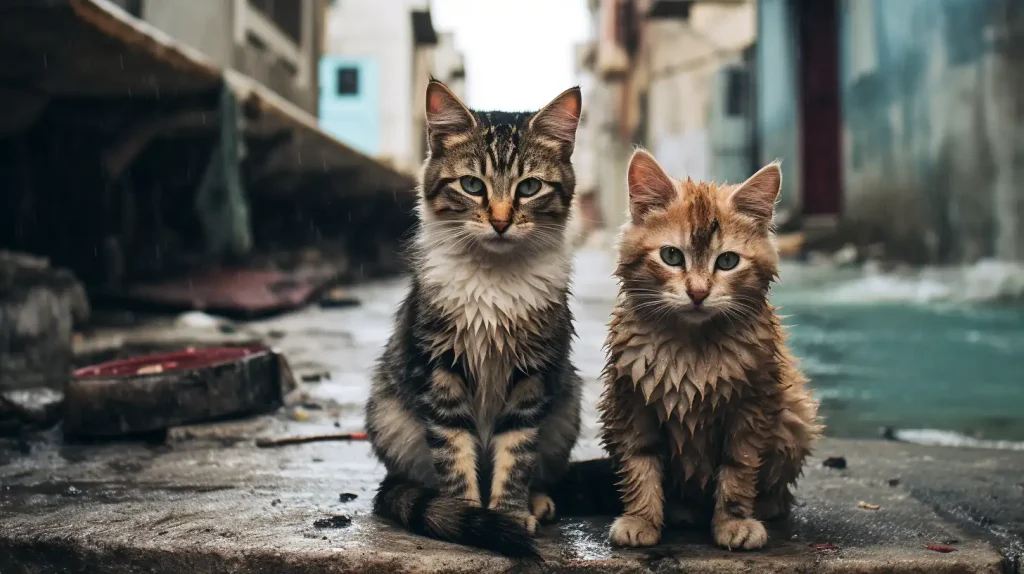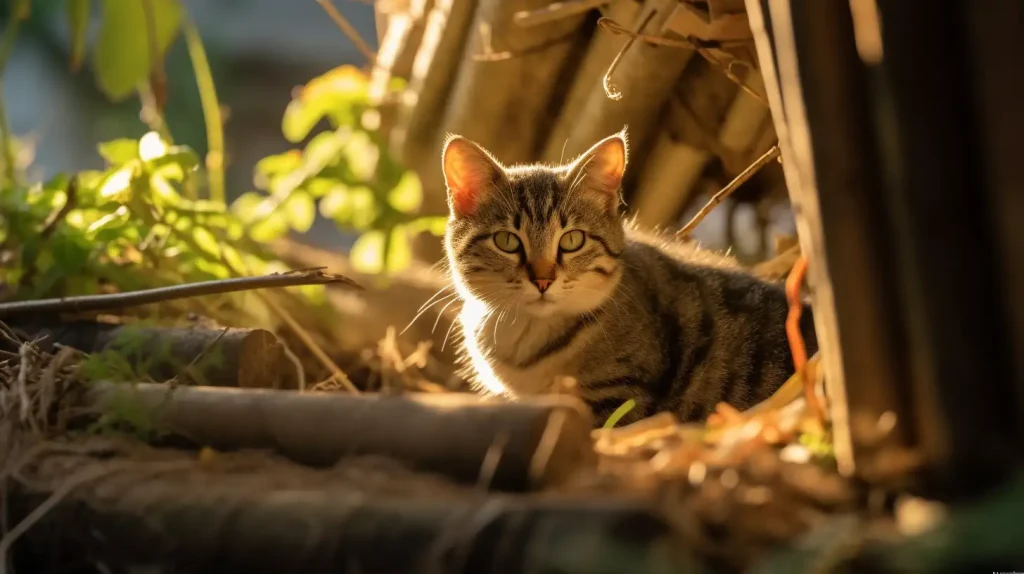Table of Contents
Stray cats are a common sight in cities and towns around the world. These feline beings roam the streets, alleys, and parks, often surviving on scraps of food and shelter in unexpected places. The global cat population is estimated to be over 600 million, with millions of cats living as strays.
Despite their challenges, these cats form unique and fascinating communities, adapting to their environments and exhibiting distinctive behavior patterns. From the alley cats of New York City to the street cats of Istanbul, these feline beings have captured the hearts of many around the world.
In this section, we will explore the lives of stray cats around the world, from their population numbers to their behavior patterns and the communities they form. We will delve into the challenges they face and the efforts made to improve their well-being.
Key Takeaways
- Stray cats are a global phenomenon, with over 600 million cats estimated to be living as strays.
- Stray cats exhibit unique behavior patterns and form communities in different parts of the world.
- Challenges faced by stray cats include finding food and shelter, avoiding danger, and managing diseases.
- Efforts are being made globally to improve the well-being of stray cats, including cat welfare initiatives, rescue organizations, and advocacy for responsible ownership.
Understanding Feral Cats and Cat Colony Management
Feral cats are those that have either never had any contact with humans or are born to stray cats. They are often misunderstood and considered a nuisance in many communities. However, it is important to understand that feral cats are not domesticated and can be difficult to socialize or adopt.
One of the biggest challenges with feral cats is cat overpopulation. Feral cats reproduce quickly and can cause disruptions in ecosystems. This is where cat colony management comes in. Cat colony management involves trapping, neutering, and releasing feral cats. This process can help control cat populations and prevent the birth of new litters.
Many organizations and communities have implemented cat colony management programs to address the issue of cat overpopulation. By neutering and spaying feral cats, these programs aim to reduce the number of cats in a given area and promote a healthier environment for both cats and humans.
While some may argue that euthanasia is a more effective solution, many animal welfare organizations advocate for humane alternatives such as trap-neuter-return programs. These programs not only help control cat populations, but also improve the overall welfare of feral cats by preventing mating-related injuries and reducing instances of disease.
Ultimately, managing feral cat colonies is a challenging process that requires collaboration between animal welfare organizations, local governments, and community members. By working together to implement effective cat colony management programs, we can help ensure the well-being of both feral cats and the communities they inhabit.
Stray Cat Welfare Initiatives and Rescue Organizations
In recent years, there has been increasing awareness and concern for the well-being of stray cats around the world. This has led to the formation of numerous cat rescue organizations and welfare initiatives aimed at improving their lives.
These organizations work tirelessly to rescue stray cats from the streets, provide them with medical care, and find them loving homes through adoption programs. Many also implement trap-neuter-return (TNR) programs, which help to manage the cat population and reduce the number of cats living on the streets.
Stray cat adoption is another crucial component of these initiatives. Many rescue organizations provide opportunities for individuals and families to give a loving home to a stray cat. By adopting a stray cat, individuals are not only providing the cat with a better life but also helping to reduce the overall population of stray cats.
Cat welfare initiatives also play a significant role in improving the lives of stray cats. These initiatives include education programs for responsible cat ownership, community outreach programs, and advocacy efforts for animal welfare laws and regulations.
Overall, the work of cat rescue organizations and welfare initiatives is essential in improving the lives of stray cats around the world. By supporting these initiatives, individuals can make a meaningful difference in the lives of these remarkable feline beings.
Global Cat Care and Environmental Factors
The lives of stray cats are shaped by the environments in which they dwell. Unique stories of survival and community formation are found globally, highlighting the need for global cat care initiatives.
Factors such as climate, urbanization, and wildlife affect the well-being of stray cats. In colder regions, for example, food scarcity and harsh outdoor conditions often result in high mortality rates. In contrast, cats in warmer areas may be more susceptible to diseases such as rabies and feline leukemia.
Urbanization presents a challenge for cats, as access to food and shelter becomes limited. Stray cats may have to compete with other wildlife for resources, and conflicts, such as those with birds and rodents, may arise.
Despite these challenges, cats have adapted to various environments, including cities, rural areas, and even islands. The unique stories of feline communities worldwide demonstrate their resilience and the importance of providing adequate care for their well-being.
Island Cats of Japan
Japan hosts a unique population of stray cats living on remote islands. These cats, believed to have been brought over by fishermen centuries ago, have adapted to island life in fascinating ways. They have developed their own dialects, hunting methods, and even protect their territory from outsiders!
Street Cats of Istanbul
In Istanbul, Turkey, thousands of stray cats roam the streets, parks, and alleys. The city’s residents have embraced these cats, feeding them and even building them shelters. In turn, the cats have become an integral part of Istanbul’s culture, with many of them becoming local celebrities.
Global cat care initiatives must take into account the various environmental factors impacting cats worldwide. By recognizing the unique stories and challenges of stray cats, we can provide them with the proper care they need to thrive.
Cat Overpopulation Solutions and Awareness Campaigns
The issue of cat overpopulation is a global concern that needs urgent attention. The problem is particularly significant in developing countries due to a lack of spaying and neutering programs, leading to uncontrolled breeding and high numbers of stray cats on the streets.
To address this issue, several solutions have been put in place, including trap-neuter-return programs (TNR) and spay-neuter programs. TNR involves trapping feral cats, neutering or spaying them, and then releasing them back into their colonies. This approach reduces the breeding rates and the number of cats on the streets. Spay-neuter programs, on the other hand, target owned cats and are aimed at preventing unplanned litters.
Alongside these solutions, awareness campaigns play an important role in promoting responsible cat ownership and population control. These campaigns educate the public on the importance of spaying and neutering their cats, the benefits of adopting a cat from a shelter, and the risks associated with abandoning cats on the streets.
Global cat care is another critical issue as cat populations continue to grow around the world. Providing adequate food, water, and shelter for stray cats can significantly improve their well-being. Community-based programs that engage and involve local residents in caring for stray cats have been successful in many areas.
Cat overpopulation solutions and awareness campaigns require funding and support from the community. You can contribute by volunteering at a cat rescue organization, donating to a cat welfare initiative, or advocating for responsible cat ownership in your community. Together, we can make a difference in the lives of stray cats around the world.
Conclusion
In conclusion, the lives of stray cats around the world are both fascinating and challenging. Throughout this article, we have explored the diverse global cat populations and their behaviors, the importance of cat colony management and overpopulation solutions, the efforts made by cat welfare initiatives and rescue organizations, and the impact of environmental factors on their well-being.
Despite the challenges, there is hope for improving the lives of stray cats. By supporting cat rescue organizations and promoting responsible ownership, we can make a positive impact on their welfare. Additionally, awareness campaigns can help educate the public on responsible behavior towards cats, such as spaying and neutering, and discouraging abandonment.
It is crucial to acknowledge the unique stories of stray cats around the world and provide them with the necessary care and resources to thrive. By understanding their behavior and the challenges they face, we can work towards creating a brighter future for these remarkable feline beings.



